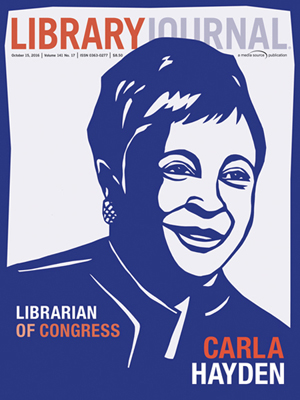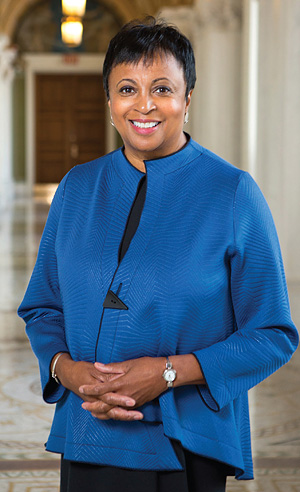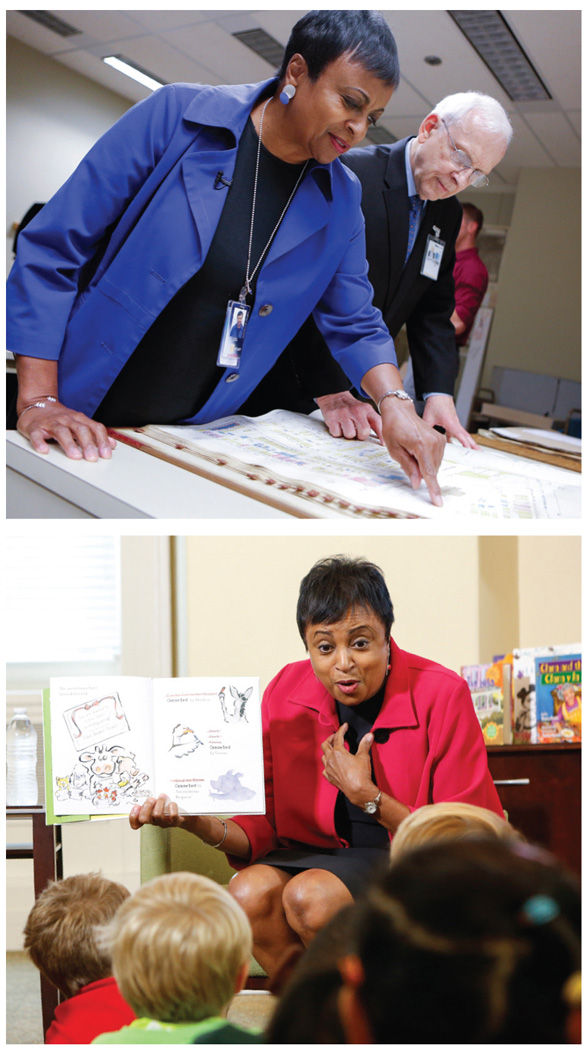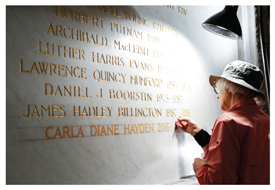Librarian of the People | LJ Interview

Illustration by Miriam Klein Stahl
On September 14, Dr. Carla Hayden was sworn in as the new Librarian of Congress. The first African American and the first woman to hold the position in American history, she is also only the third to have worked in a library prior to her appointment. After a moving ceremony in the Library of Congress’s (LC) 1897 Jefferson Building and a reception to meet “as many staff members as they could stand,” Hayden sat down with LJ in her ceremonial office to outline her vision for the library.
Her overarching goal for LC, Hayden says, is “to expand its reach through a variety of formats, and what I’m most pleased about is that there are so many opportunities.”
Hayden is seizing those opportunities as soon as they present themselves. Case in point, she planned to announce to LC staff on October 10 that the ceremonial office would be open to the public for the first time, allowing visitors to view the elaborate Italian style décor, historic furnishings, and the balcony intended for musicians and poets to perform and inspire the librarian at work. (She has a regular working office in the nearby Madison Building).
Spotlight on staff
It’s not just her own vision that she wants to implement: Hayden told LJ that all the staff members she is meeting with have ideas they want to share.
That’s a lot of ideas: Hayden’s initial meeting with staff was just the beginning of what she referred to as a “grand listening tour…to get in-depth information and knowledge and experience,” which started with meeting key staffing units on her first full day in office and will involve visiting every single LC facility and service, including the National Library for the Blind and Physically Handicapped and the Packard Campus for Audio-Visual Conservation’s state-of-the-art film preservation storage constructed in a historic bunker in Culpeper, VA.
Even before she was sworn in, Hayden had met with LC’s Chief Information Officer Bernard “Bud” Barton several times, “but now we need to get much more in-depth,” she says, “to really get briefed on the progress that’s already been acknowledged by the Government Accountability Office [GAO] in addressing all the issues” in the report issued last year on LC’s technology gap. Hayden says the GAO is happy with the progress so far, but there is more work still to be done.
In addition to bringing LC’s tech up-to-date, one existing challenge Hayden inherited is a lack of storage space. Plans are already in the works for expanding storage capacity, she told LJ, through pods in an off-site location, and she’ll be working to get the appropriation to build additional pods. These may need to be able to house items requiring a more tailored climate than standard library books because, as Hayden points out, “the collections that are growing the most in this digital age are the special collections.”

Photo by Shawn Miller
So it makes sense that Hayden’s listening tour has deep roots in LC’s history as well as its future. Hayden told LJ she intends to visit the conservation department very soon to see how those staff members preserve LC’s fragile and rare materials. “When you see all the instruments, it’s like surgeons,” enthuses Hayden, “the care and the attention. Each conservator is so knowledgeable about the materials they’re working on…they know the provenance.”
Another set of lingering concerns that Hayden inherited involve diversity at LC, the subject of a Roll Call article this July. “I know that’s a concern,” Hayden says, and to learn more, she wants to meet with the leadership of the unions.
Raising the profile
Simultaneously with her proactive internal outreach, Hayden is raising the profile of LC outside its doors, starting a Twitter account (@LibnOfCongress) on the day of her ceremony that had gained almost 18,000 followers at press time. In her first few days she led a story time in LC’s Young Readers Center for three- and four-year-olds. Says Hayden, “We really want to encourage more interaction with even the young.” Hayden showed her roots in children’s librarianship by insisting on selecting eight titles to hold the kids’ attention, including Lola at the Library, and leaned on her professional network to supplement with a few newer titles recommended by the head of children’s services at Hayden’s previous longtime post, Baltimore’s Enoch Pratt Free Library. “Once a children’s librarian, always a children’s librarian,” she tweeted from the National Book Festival, below a photo of Hayden and a small child sharing the embrace of a giant Clifford the Red Dog–costumed character.
Sharing celebrity photos of authors and lawmakers and snippets of intriguing digital resources from LC’s deep archives, Hayden’s Twitter feed is a foretaste of her underlying agenda: to make LC the library of the American people, as well as of Congress, and to use a combination of in-person events and expanded digital access to accomplish it.
At her confirmation hearing in April and again at her swearing in, Hayden declared her determination to expand the library’s role beyond Washington to serve the public further as well as Congress, and particularly rural areas, something she plans to do by both digitizing more collections from LC’s extensive backlog and building online exhibits and also through LC’s traveling exhibits. Hayden cites the possibility of using replicas of rare artifacts to broaden the reach of the exhibit program beyond sites that can house originals. “My mom practiced with an exact replica of the Lincoln Bible [for the swearing in ceremony],” says Hayden, “the exact weight, everything. Wouldn’t it be nice to have a replica in an exhibit in a rural library? When I talked with legislators with rural areas in their district they said this would be great for this area or that area, because it helps them connect, too.”
Deeper collaborations
Hayden says her experience as a public as well as an academic librarian and as a past president of the American Library Association (ALA), “will enhance the work.” She’s been reading her “favorite new book” about the history of her predecessors as Librarian of Congress through the lens of each librarian’s tenure (Christian A. Nappo’s The Librarians of Congress, Rowman & Littlefield, Feb. 2016) and says, “The two times before that there were librarians that had directed public libraries, Cleveland and Boston Public, they had ties with ALA. So that synergy will continue.”
In an interview with USA Today, Hayden announced that she planned to move forward on a collaboration with the Digital Public Library of America (DPLA), something Dan Cohen, founding executive director of DPLA, told LJ at the swearing in ceremony that he was excited to see.

HANDS-ON LEADERSHIP (top): Hayden and Geography and Map Division chief Ralph Ehrenberg peruse the Sanborn Fire Insurance map collections, set to be digitized; (bottom): the new Librarian reads to children from Brent Elementary School in LC’s Young Readers Center in the historic Jefferson Building. Photos by Shawn Miller
Growing giving
At her swearing in, Hayden highlighted an increased role for private donations, or what she calls “patriotic philanthropy.” She has an extensive history of bringing in private money in her previous positions, and she looks to build on the legacy of her predecessor, Dr. James H. Billington, who founded the James Madison Council, LC’s first effort at private fundraising, and getting into what Hayden calls “that friend-raising mode.” Hayden said she was very pleased to see members of the council at the swearing in and will be working with the Madison Council to expand membership, something she calls “a wonderful opportunity to introduce people in more different fields to the collections.” Digitization is one priority area for philanthropic giving, she says, since it is “not inexpensive.” Her strategy is to introduce individual donors to collections that are “ready to go” and that align with their own favorite subjects. Says Hayden, “I’m sure they’ll be excited about it when they see collections that match their personal interests and [existing] collections.” But digitization, while important, is far from the only role for private donors. Hayden also cites the 45-acre Packard Campus, funded by the David and Lucille Packard Foundation (of Hewlett-Packard fame) as an example of the role of private contributions to LC’s mission.
Strong support
“I’ve heard from so many people during this process, and I was so heartened,” recalls Hayden, “from former library directors to former Library of Congress staff members to library school faculty—just about everybody.” The widespread and enthusiastic endorsement from the library community “meant so much to me personally,” Hayden says, but, more than that, it may have helped win her approval by the Congressional committee that governs LC and the subsequent confirmation vote. “It was impressive to the legislators,” Hayden says. “It helped quite a bit. It demonstrated that all facets of the library community—users, everybody—really supported this institution and were really vocal. All types of libraries and staffers are invested in the support of the Library of Congress, and when [lawmakers] hear from their constituents that the Library of Congress helps them, it resonates.”
Another big help in building relationships with the members of Congress who confirmed her selection was the library’s oldest and most traditional role: that of keeping Congress informed, particularly the relationship that members of the Congressional Research Service (CRS)—for which Hayden is bringing back the nickname “the special forces”—have with the representatives and their staffs. Says Hayden, “It really helped when I was meeting a lot of Congress members and their staff[s] that they had such respect for CRS.” With Hayden the first Librarian of Congress to serve a term renewable every ten years, rather than as a lifetime appointment, keeping connections to Congress strong will be just as important in the future.
In her first days in office, a mainstream media blitz, including appearances on PBS, CBS, and Fox News, among others, shows Hayden is fully prepared to use her honeymoon period and the interest generated by her historic appointment to start outreach to the public immediately, even as she sets LC’s house in order behind the scenes. It’s a big to-do list, especially on top of a daily commute from Baltimore, but Hayden’s excitement, enthusiasm, and deep expertise show she’s up to the challenge.
 Librarians of Congress
Librarians of Congress
John James Beckley 1802–07, politician (clerk of the House of Representatives)
Patrick Magruder 1807–15, lawyer and politician
George Watterston 1815–29, novelist and journalist
John Silva Meehan 1829–61, printer and newspaper publisher
John G. Stephenson 1861–64, physician
Ainsworth Rand Spofford 1864–97, editor
John Russell Young 1897–99, journalist and former diplomat
Herbert Putnam 1899–1939, superintendent, Boston Public Library; American Library Association (ALA) president, January–August 1898 and 1903–04
Archibald Macleish 1939–44, poet and writer
Luther Evans 1945–53, political scientist, professor, director of the Historical Records Survey of the Works Progress Administration
Lawrence Quincy Mumford 1954–74, director, Cleveland Public Library; ALA president, 1954–55
Daniel J. Boorstin 1975–87, professor and director of the Smithsonian Institution
James H. Billington 1987–2015, Russian scholar and historian
Carla D. Hayden 2016–, CEO, Enoch Pratt Free Library, Baltimore; ALA president, 2003–04
Photo by Shawn Miller
RELATED
ALREADY A SUBSCRIBER? LOG IN
We are currently offering this content for free. Sign up now to activate your personal profile, where you can save articles for future viewing









Add Comment :-
Comment Policy:
Comment should not be empty !!!